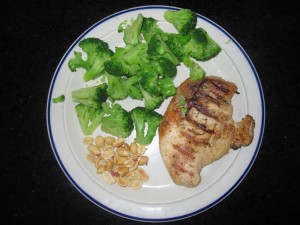- Is a Paleo diet right for you?
- Do you like meat and vegetables?
- Looking for a way to mix up your nutrition?
 The Paleo Diet is based upon every day, modern foods that mimic the food groups of our pre-agricultural, hunter-gatherer ancestors. The following seven fundamental characteristics of a Paleo nutrition plan are said to help to improve health, reduce risk of chronic disease, and lose weight.
The Paleo Diet is based upon every day, modern foods that mimic the food groups of our pre-agricultural, hunter-gatherer ancestors. The following seven fundamental characteristics of a Paleo nutrition plan are said to help to improve health, reduce risk of chronic disease, and lose weight.
But, as with any nutrition plan, it will only works if it is something you can stick to; something you will enjoy eating every day. So is the Paleo Diet right for you?
This list comes from thepaleodiet.com
- Higher protein intake – Protein comprises 15 % of the calories in the average western diet. It is 19-35 % in hunter-gatherer diets. Meat, seafood, and other animal products represent the staple foods of modern day Paleo diets.
- Lower carbohydrate intake and lower glycemic index – Non-starchy fresh fruits and vegetables represent the main carbohydrate source and will provide for 35-45 % of your daily calories. Almost all of these foods have low glycemic indices that are slowly digested and absorbed, and won’t spike blood sugar levels.
- Higher fiber intake – Dietary fiber is essential for good health, and whole grains aren’t the place to find it. Non-starchy vegetables contain eight times more fiber than whole grains and 31 times more than refined grains. Even fruits contain twice as much fiber as whole grains and seven times more than refined grains.
- Moderate to higher fat intake dominated by monounsaturated and polyunsaturated fats with balanced Omega-3 and Omega-6 fats – It is not the total amount of fat in your diet that raises your blood cholesterol levels and increases your risk for heart disease, cancer, and type 2 diabetes, but rather the type of fat. Cut the trans fats and the Omega-6 polyunsaturated fats and increase the healthy monounsaturated and Omega-3 fats that were the mainstays of Stone Age diets.
- Higher potassium and lower sodium intake – Unprocessed, fresh foods naturally contain 5 to 10 times more potassium than sodium. Potassium is necessary for the heart, kidneys, and other organs to work properly. Low potassium is associated with high blood pressure, heart disease, and stroke – the same problems linked to excessive dietary sodium. Today, the average American consumes about twice as much sodium as potassium.
- Higher intake of, vitamins, minerals, antioxidants, and plant phytochemicals – Whole grains are not a good substitute for grass produced or free ranging meats, fruits, and veggies, as they contain no vitamin C, vitamin A, or vitamin B12. Many of the minerals and some of the B vitamins whole grains do contain are not well absorbed by the body.
So then, what should you eat if you follow the paleo plan? Unfortunately for me, peanuts are not on the list…I love peanuts (did you know they are a legume?) …and peanut butter. Other nuts are allowed though.
Here is a very short list of the basic types of food. For a more comprehensive list check here.
EAT
- Grass-fed meats
- Fish/seafood
- Fresh fruits
- Fresh vegetables
- Eggs
- Nuts
- Seeds
- Healthy oils (olive, walnut, flaxseed, macadamia, avocado, coconut)
DON’T EAT
- Cereal grains
- Legumes (including peanuts)
- Dairy
- Refined sugar
- Potatoes
- Processed foods
- Overly salty foods
- Refined vegetable oils
- Candy/junk/processed food

